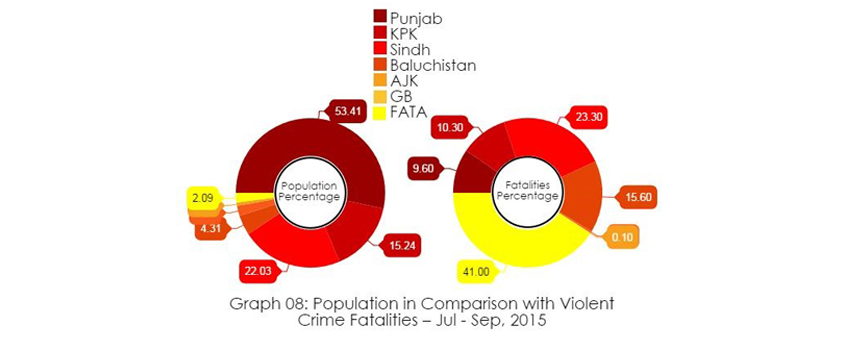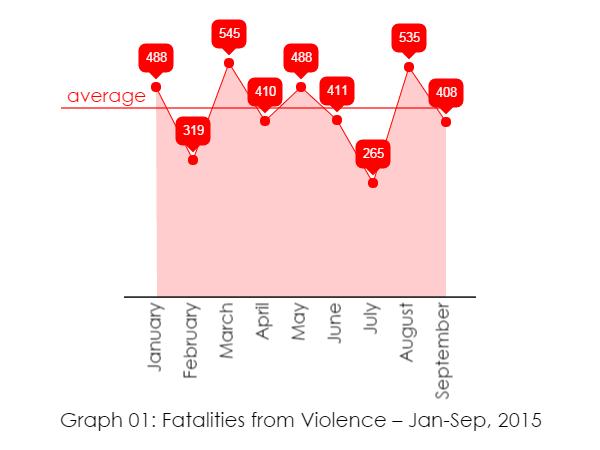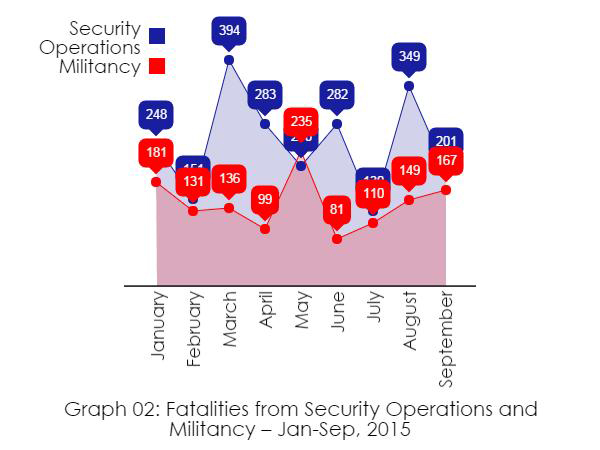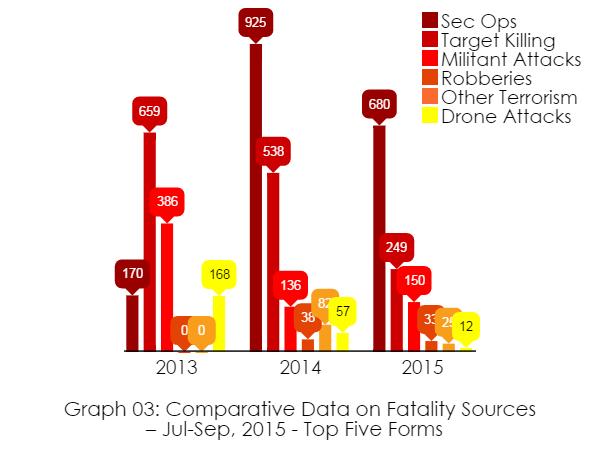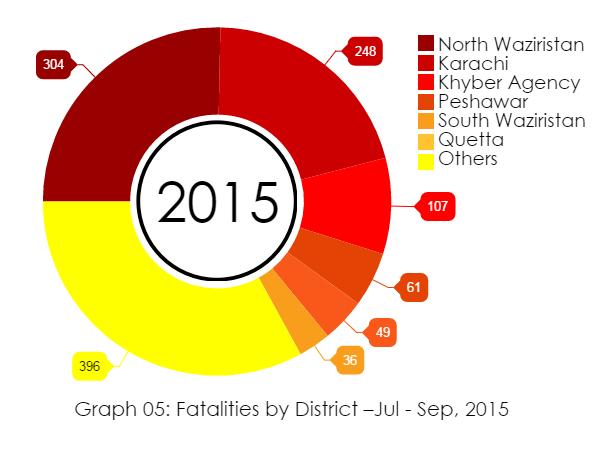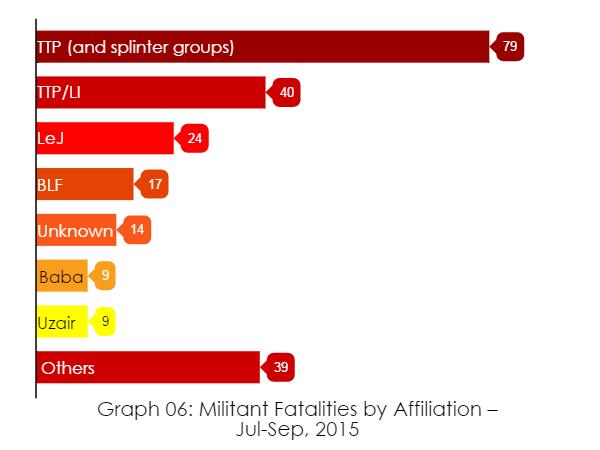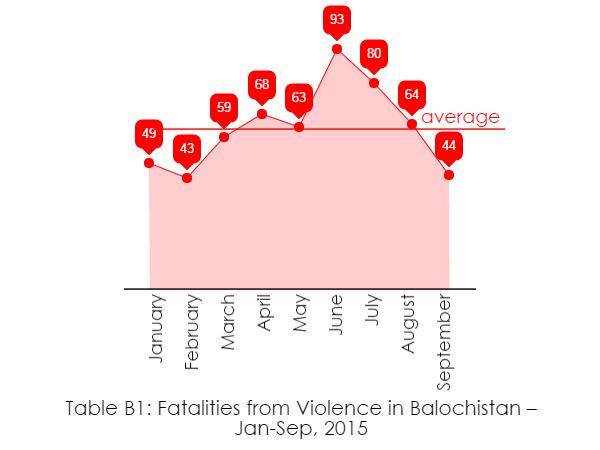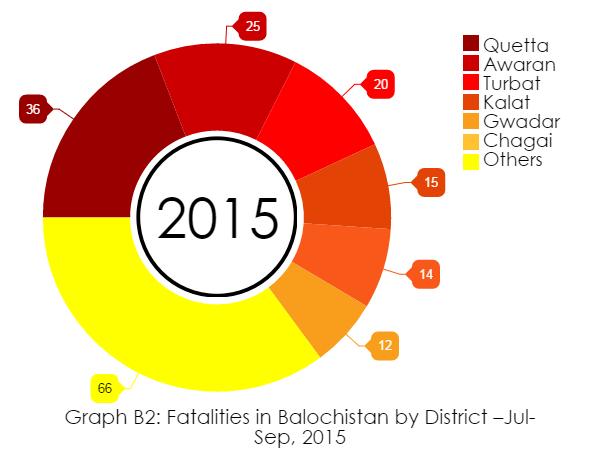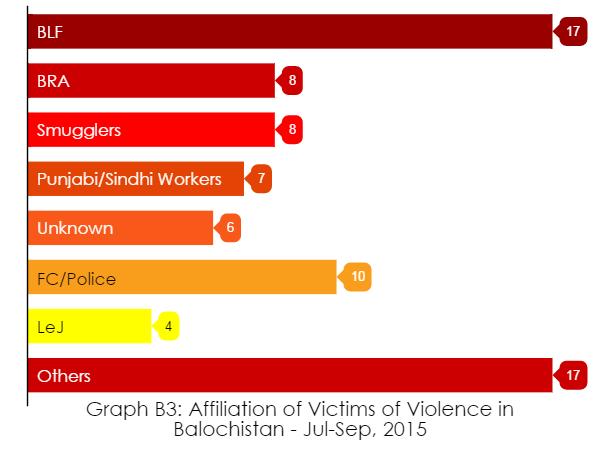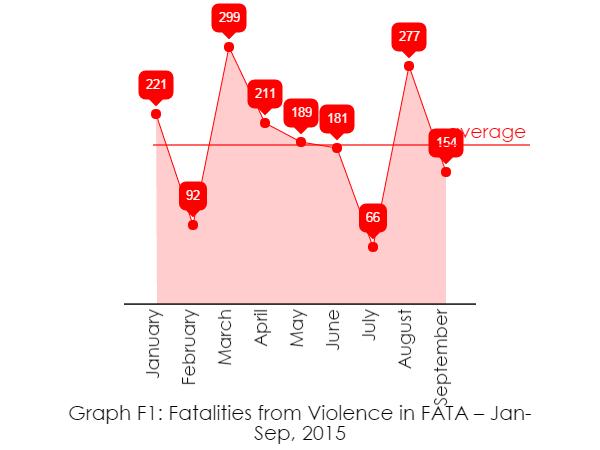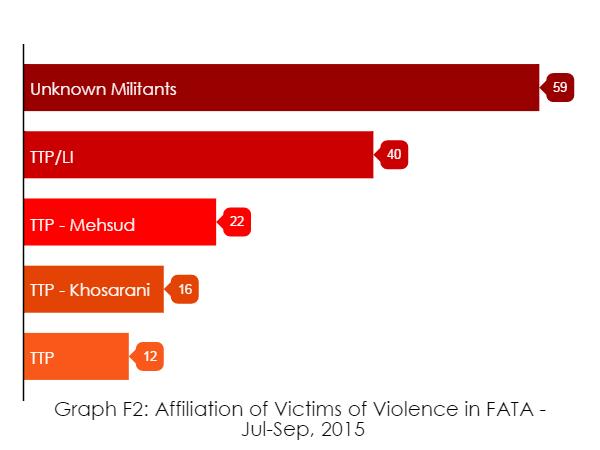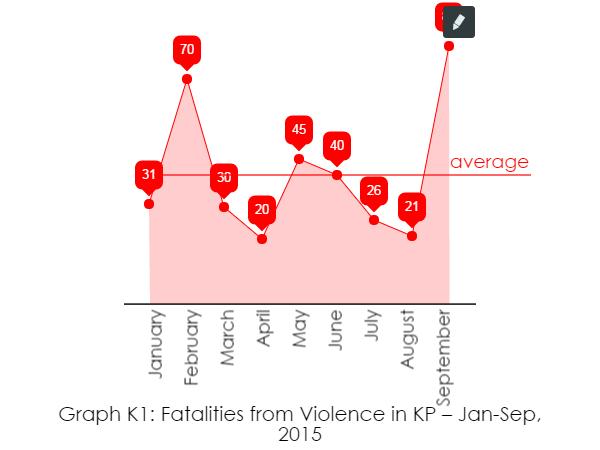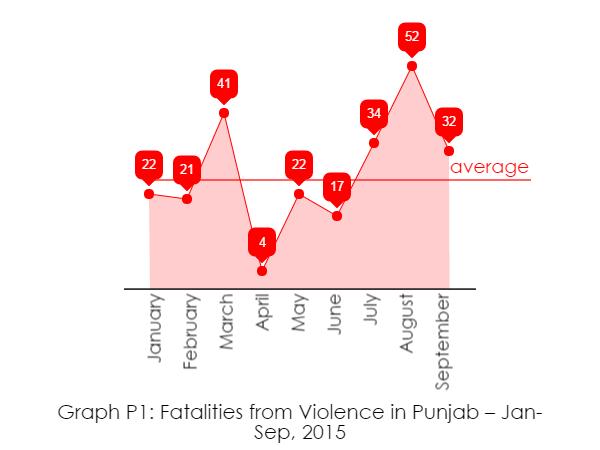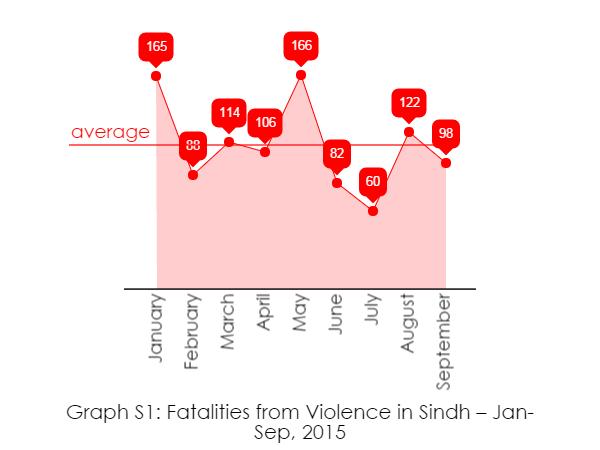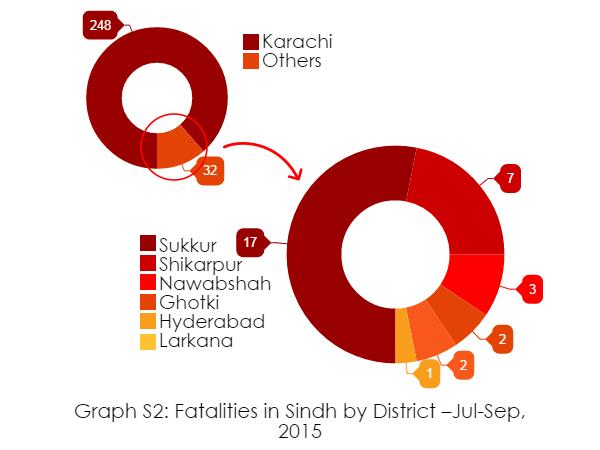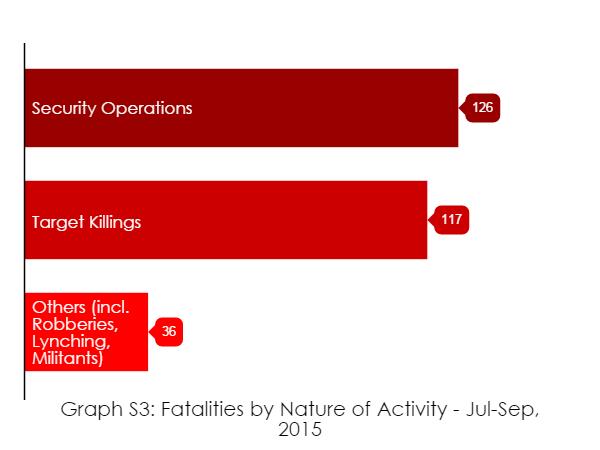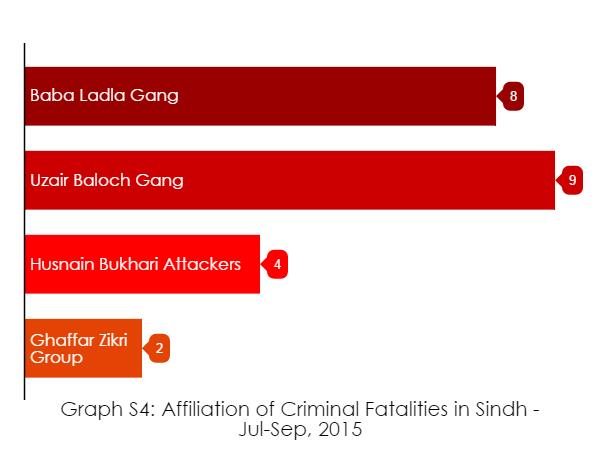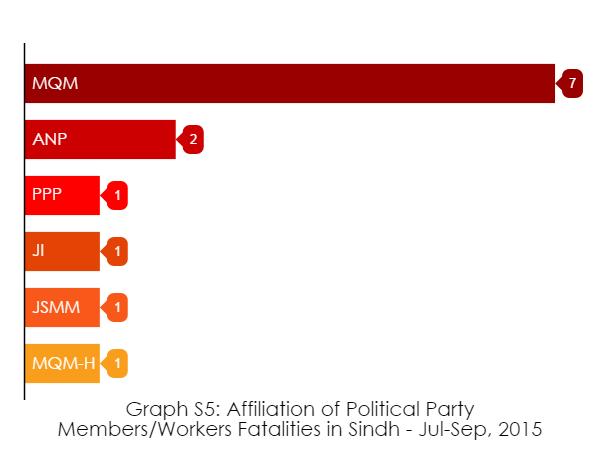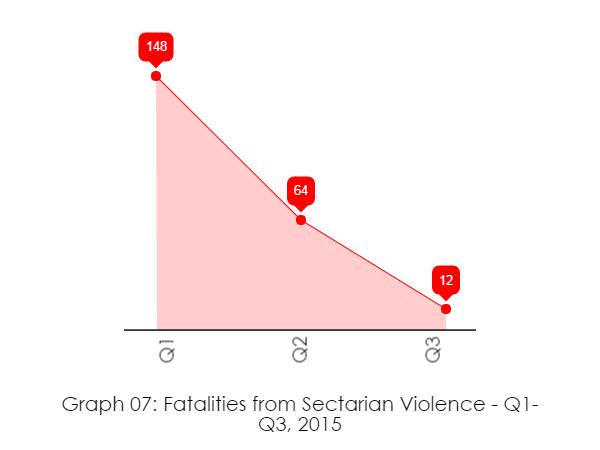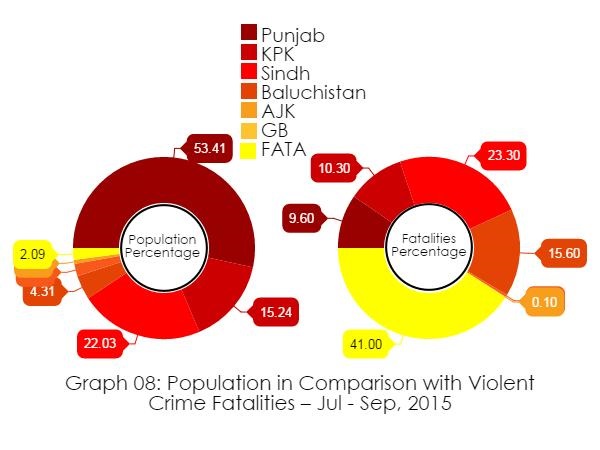Third Quarter 2015 – Introduction
Pakistan’s war on terror and criminal gangs continued to expand during the July-September quarter as security forces extended their operations to thus far untouched areas. Military/civilian law enforcement agencies unveiled alleged links among certain local and foreign non-state actors. In counterterrorism raids, security officials claimed to have tracked and nabbed terror financiers and agents of the Indian intelligence outfit Research and Analysis Wing (RAW) from various locations in Karachi, the country’s commercial and financial capital.
While security forces claimed success on different fronts, terrorists and religiously-inspired militants retaliated with brazen attacks on security installations in the country and made their presence felt. These non-state actors also appear to have adopted new strategies and tactics to deal with the ongoing operations in the south (Karachi) and northwestern territories against them. But barring a few exceptions, Pakistan recorded a decline in violence during this quarter, especially the sectarian kind. The frequency of many forms of violence also declined during this quarter.
As a whole as many as 1,208 people – civilians and security forces alike – fell to terror and crime, bringing the total fatalities in the first nine months to 3,869[1].
This report takes a close look at the ongoing security operations and the trend of violence in different parts of the country using the factual open source data collected from various national newspapers including The News, Dawn, and Express Tribune.
Errors and omissions, a possibility in all statistical works, can occur in this report as well.
Report prepared by:
Mohammad Nafees
Senior Research Fellow
Center for Research and Security Studies
NOTE: Readers can approach CRSS for source of any information included in the report. Please send your requests/comments/questions to: info@crss.pk.
List of Acronyms
| # | Acronyms (in alphabetical order) | |
| 1 | ANP | Awami National Party |
| 2 | AJK | Azad Jammu and Kashmir |
| 3 | BLF | Balochistan Liberation Front |
| 4 | BRA | Baloch Republican Army |
| 5 | BSNM | Balochistan Sub-Nationalist Movement |
| 6 | DEA | Drug Enforcement Agency |
| 7 | FATA | Federally Administered Tribal Areas |
| 8 | FC | Frontier Corps |
| 9 | GB | Gilgit Baltistan |
| 10 | IS | Islamic State (Daesh) |
| 11 | JSQM | Jeay Sindh Qaumi Mahaz |
| 12 | KP | Khyber Pukhtunkwa |
| 13 | LEA | Law Enforcement Agencies |
| 14 | LeJ | Lashkar-e-Jhangvi |
| 15 | LI | Lashkar-e-Islami |
| 16 | MQM | Muttahida Qaumi Movement |
| 17 | PMLN | Pakistan Muslim League – Nawaz Group |
| 18 | PPP | Pakistan People’s Party |
| 19 | PTI | Pakistan Tehrik-e-Insaaf |
| 20 | TTP | Tehrik-e-Taliban Pakistan |
| 21 | UBA/BLA | United Baloch Army/Baloch Liberation Army |
| 22 | ISPR | Inter-Services Public Relations |
| 23 | NWA | North Waziristan Agency |
| 24 | BLA | Balochistan Liberation Army |
| 25 | SSP | Sipah-e-Sahaba Pakistan |
| 26 | AQ | Al-Qaeda |
| 27 | AQIS | Al-Queda in the Indian Subcontinent |
| 28 | JI | Jamaat-e-Islami |
| 29 | MQM-H | Muttahida Qaumi Movement – Haqiqi Group |
| 30 | JSMM | Jeay Sindh Muttahida Mahaz |
| 31 | SSGC | Sui Southern Gas Corporation |
Q3 – Security Report
Fatalities from Violence
Despite the ongoing military operations, violence in the country claimed the lives of 1,208 persons and injured another 404 during this quarter (table 01). The linear plotting of the fatalities from violence shows an overall decline in its trend.
| Table 01: Fatalities from Violence – Jan-Sep, 2015 | |||
| Month | Fatalities | Injured | Total Casualties |
| January, 2015 | 488 | 192 | 569 |
| February, 2015 | 319 | 174 | 490 |
| March, 2015 | 545 | 287 | 832 |
| April, 2015 | 410 | 108 | 518 |
| May, 2015 | 488 | 192 | 680 |
| June, 2015 | 411 | 96 | 507 |
| July, 2015 | 265 | 86 | 351 |
| August, 2015 | 535 | 90 | 625 |
| September, 2015 | 408 | 228 | 636 |
| Total | 3869 | 1453 | 5208 |
A report published by the Washington Post claimed, “Over the past nine months, government statistics show, major terrorist attacks have declined 70% and Pakistanis are flocking back to shopping malls, resorts and restaurants[2].” A review of fatalities from acts of militancy and security operations during the last nine months showed a decline in militancy, though not as pronounced as the Washington Post source claimed (table 02).
Violence decreased significantly when compared against the data from the last two years (table 03). Also noteworthy is the disappearance or reduction in some forms of violence such as gang wars in the Karachi, infighting among terrorist and militant networks, and the sectarian rivalries. Even the fatalities from US drone attacks went down to 12 in this quarter. Some new forms of violence also emerged during this period and one of them was the cross-border attacks from Afghanistan-based Pakistani militants that killed security personnel manning the check posts around the border regions.
This quarter also saw the induction of a new counter-terror weapon, i.e., Pakistan-made unmanned aerial vehicles – also known as drones, when the Inter-Services Public Relations (ISPR) announced (on September 8, 2015) to have killed three high-profile terrorists[3]. Indigenous drones were used to hit a terrorist compound in Shawaal, North Waziristan. The attack killed three high-profile terrorists, the ISPR claimed.
On the provincial level, Sindh and Khyber Pukhtunkhwa (KP) witnessed a sharp decline in the number of fatalities from violence. Punjab saw a steep rise, well over twice the number of fatalities from the same period in 2014. Balochistan also had a marginal increase in the number of fatalities (table 04).
District-wise, the North Waziristan Agency (NWA) had the highest number of fatalities owing to the ongoing military operation in the region. The Karachi district recorded the second highest number of fatalities but it was half the numbers recorded in 2014 during the same period. The districts of Attock, Muzaffargarh, Kalat, Multan, and Nasirabad recorded double digit fatalities during this quarter while in the corresponding period of the last two years these districts remained largely unaffected by violence-related fatalities (table 05).
Among the militants and outlawed gangsters killed in the ongoing operations, splinter groups of the outlawed Tehreek-e-Taliban of Pakistan (TTP) suffered the highest number of fatalities (table 06). There were also reports of fatalities of militants belonging to TTP and Lashkar-e-Islami (LI) in the Khyber Agency – a district of the Federally Administered Tribal Areas (FATA)) during security operations in the area. It should be noted that TTP and LI have joined hands to fight against the security forces in the mountainous Tirah Valley of the Khyber Agency.
| Table 06: Militant Fatalities by Affiliation – Jul-Sep, 2015 | |
| Group | Fatalities |
| TTP (and splinter groups) | 79 |
| TTP/LI | 40 |
| Lashkar-e-Jhangvi (LeJ) | 24 |
| Balochistan Liberation Force (BLF) | 17 |
| Banned outfit and/or unknown affiliation | 14 |
| Baba Ladla Gang | 9 |
| Uzair Baloch Gang | 9 |
| Balochistan Republican Army (BRA) | 8 |
| Smugglers | 8 |
| Balochistan Liberation Army (BLA) | 6 |
| Sipah-e-Sahaba Pakistan (SSP) / Al-Qaeda (AQ) | 5 |
| Adv. Husnain Bukhari murderer | 4 |
| Afghan Taliban | 4 |
| Al-Qaeda Pakistan | 4 |
| Total | 231 |
Fatalities from Violence in Balochistan
In the third quarter of 2015, a total of 244 casualties were recorded in Balochistan (188 dead and 56 injured). In the same period in 2013 and 2014, Balochistan had lost 267 and 174 persons respectively. The number of fatalities during this quarter is approximately 30% lower than the figure of 2013, but it is higher than the figure of 2014. This also underscores the volatility and unpredictability of the security landscape of this embattled province. Although, Balochistan had a declining trend in the number of fatalities during the last three months, the linear plotting of the fatalities for the first nine months of this year reflects an upward trend in fatalities from violence in the province.
| Table B1: Fatalities from Violence – Balochistan – Jan-Sep, 2015 | |||
| Month | Fatalities | Injured | Total Casualties |
| January, 2015 | 49 | 14 | 63 |
| February, 2015 | 43 | 48 | 91 |
| March, 2015 | 59 | 13 | 72 |
| April, 2015 | 68 | 30 | 98 |
| May, 2015 | 63 | 30 | 93 |
| June, 2015 | 93 | 10 | 103 |
| July, 2015 | 80 | 33 | 113 |
| August, 2015 | 64 | 21 | 85 |
| September, 2015 | 44 | 2 | 46 |
| Total | 563 | 201 | 764 |
This also underscores the continuous challenge that criminal and terrorist syndicates post to the security in the region. On August 30, 2015, for instance, about a dozen armed men riding six motorcycles attacked the Jiwani Airport, killing a Civil Aviation Agency (CAA) engineer and kidnapping the airport manager. The latter’s dead body was found later near the airport. Three days later militants fired two rockets at the airport.
On September 13, 2015, nearly 15 armed men fired rockets at a village in the Shindi area of Awaran district’s Jaho tehsil. They then entered the village and torched around 20 houses, including that of the deputy speaker of the Balochistan Assembly. Coincidently, Awaran is among the Baloch districts that recorded the highest surge in fatalities during this quarter when compared against the second quarter of this year (table B2).
| Table B2: Fatalities in Balochistan by District – Apr-Sep, 2015 | ||
| District Fatalities | Apr-Jun | Jul – Sep |
| Quetta | 32 | 36 |
| Awaran | 4 | 25 |
| Turbat | 35 | 20 |
| Kalat | 42 | 15 |
| Gwadar | 9 | 14 |
| Chagai | 0 | 12 |
| Nasirabad | 2 | 10 |
| Dera Bugti | 24 | 8 |
| Khuzdar | 0 | 8 |
| Pasni | 0 | 8 |
| Taftan | 0 | 8 |
| Nushki | 4 | 4 |
| Panjgur | 15 | 3 |
| Pishin | 0 | 3 |
| Sibi | 4 | 3 |
| Baseema | 0 | 2 |
| Bolan | 4 | 0 |
| Hub | 2 | 0 |
| Jaffarabad | 1 | 0 |
| Kohlu | 1 | 0 |
| Loralai | 3 | 0 |
| Mastung | 35 | 0 |
| Zhob | 1 | 0 |
| Ziarat | 6 | 0 |
| Others | 0 | 9 |
| Total | 224 | 188 |
Unknown militants also targeted people on ethnic grounds, though the number of casualties showed a decline. Table B3 below depicts the losses for both law enforcement agencies, banned/insurgent outfits, and other groups during Q3, 2015.
| Table B3: Affiliation of Victims of Violence in Balochistan – Apr-Sep, 2015 | |||
| Affiliation | Apr-Jun | Jul – Sep | |
| BLF | 0 | 17 | |
| BRA | 18 | 8 | |
| Smugglers | 0 | 8 | |
| Punjabi/Sindhi workers | 20 | 7 | |
| Banned outfit (unknown affiliation) | 0 | 6 | |
| FC | 3 | 6 | |
| LeJ | 0 | 4 | |
| Police | 7 | 4 | |
| Shia Hazara | 14 | 3 | |
| Others | 0 | 14 | |
| Total | 189 | 77 | |
| Note: Several categories, such as Army, BSNM and infighting victims are not a part of the Q3, but they were a part of the Q2 data. | |||
Fatalities from Violence in FATA
The Federally Administered Tribal Areas (FATA) recorded 609 casualties (497 dead and 112 injured) during the third quarter of this year (table F1). No significant decline in fatalities from violence was observed during the first three quarters of this year.
| Table F1: Fatalities from Violence – FATA – Jan-Sep, 2015 | |||
| Month | Fatalities | Injured | Total Casualties |
| January, 2015 | 221 | 51 | 272 |
| February, 2015 | 92 | 38 | 130 |
| March, 2015 | 299 | 143 | 442 |
| April, 2015 | 211 | 31 | 242 |
| May, 2015 | 189 | 71 | 260 |
| June, 2015 | 181 | 24 | 205 |
| July, 2015 | 66 | 9 | 75 |
| August, 2015 | 277 | 20 | 297 |
| September, 2015 | 154 | 83 | 237 |
| Total | 1690 | 470 | 2160 |
During the Q3, the number of fatalities went up because of the escalation in military operations, largely in response to militant attacks elsewhere in the country. The major precipitating militant attacks included a raid on a check post in the Tirah Valley on July 5, a suicide attack in Attock that claimed the lives of 24 people, including Punjab’s Home Minister Colonel (retd.) Shuja Khanzada on August 16, and the brazen attack on the Badaber Air Base in Peshawar on September 18. The following table depicts losses for militants, insurgents and other proscribed outfits for this quarter.
| Table F2: Militant Fatalities in FATA by Affiliation – Jul – Sep, 2015 | ||
| Group | 2014 | 2015 |
| Unknown Militants | 1 | 59 |
| TTP/LI | 0 | 40 |
| TTP – Mehsud | 0 | 22 |
| TTP – Khosarani | 0 | 16 |
| TTP | 7 | 12 |
| Al-Qaeda | 1 | 0 |
| Lashkar-e-Islam (LI) | 8 | 0 |
| Militants/Peace Committee | 8 | 0 |
| Peace Committee/LI | 2 | 0 |
| TI/LI | 3 | 0 |
| TTP – Jangraiz group | 4 | 0 |
| TTP – Punjab/Hafiz Gul Bahadur group | 0 | 0 |
| TTP – Gedar group | 2 | 0 |
| TTP – Suspect | 2 | 0 |
| Total | 30 | 149 |
Fatalities from Violence in Khyber Pukhtunkhwa
KP suffered about 202 casualties in Q3, 2015 (127 fatalities, 75 injured). After several months of low level of violence in KP, a sudden resurge in September surprised officials. The data for the nine months of this year also showed a slightly upward trend (table K1).
| Table K1: Fatalities from Violence – KP – January-Sep 2015 | |||
| Month | Fatalities | Injured | Total Casualties |
| January, 2015 | 31 | 4 | 35 |
| February, 2015 | 70 | 70 | 140 |
| March, 2015 | 30 | 11 | 41 |
| April, 2015 | 20 | 35 | 55 |
| May, 2015 | 45 | 80 | 125 |
| June, 2015 | 40 | 57 | 97 |
| July, 2015 | 26 | 22 | 48 |
| August, 2015 | 21 | 4 | 25 |
| September, 2015 | 80 | 49 | 129 |
| Total | 363 | 332 | 695 |
Since the horrendous attack on innocent schoolchildren at the Army Public School in December 2014, the September 18, 2015 terrorist raid on the PAF Base in Badaber, Peshawar was the most brazen. It left 43 dead, including the 14 attackers. The remaining 29 persons were military servicemen. This was the second major attack by the militants in KP where they managed to penetrate a tight security cordon.
Table K2 depicts comparative data of the victims of violence during the third quarter in 2015 and 2014. It also shows that, compared to last year, the fatalities of violence in KP during the third quarter of this year declined by 35%, compared to the corresponding period in 2014.
However, a major issue of concern is the fatalities of the non-combatant population. Last year, 117 non-combatants (civilians, political activists, religious party activists and religious persons) became the victims of violence as against 54 militants and criminals. This year, there was a 50% decrease in the fatalities of non-combatants. Fatalities of the security personnel went up from 24 in third quarter of 2014 to 54 during this year so far. The percentage of the fatalities of militants and criminals remained almost the same during this quarter and last year.
| Table K2: Victims of Violence in KP – Jul – Sep, 2014/2015 | ||||
| Victims | 2014 | % of total | 2015 | % of total |
| Security officials | 24 | 12.10 | 54 | 42.50 |
| Civilians | 105 | 53.00 | 31 | 24.40 |
| Political party activists | 5 | 2.50 | 7 | 5.50 |
| Religious persons | 4 | 2.00 | 1 | 0.80 |
| Militants | 50 | 25.30 | 29 | 22.80 |
| Criminals | 4 | 2.00 | 5 | 3.90 |
| Religious party activists | 3 | 1.50 | 0 | 0.00 |
| Govt officials | 2 | 1.00 | 0 | 0.00 |
| Foreigner | 1 | 0.50 | 0 | 0.00 |
| Total | 198 | 127 | ||
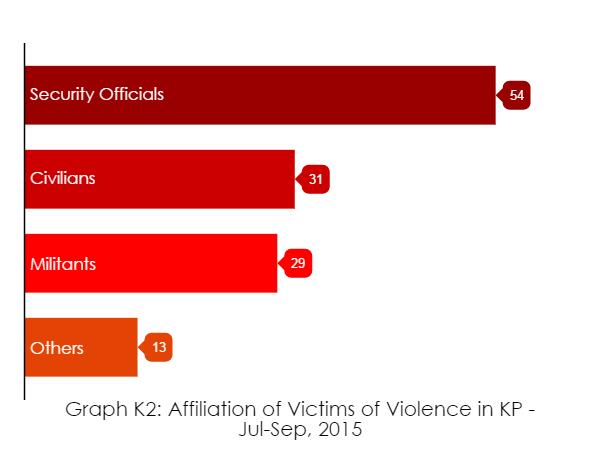
Fatalities from Violence in Punjab
After a significantly longer period of low crime and violence, Punjab witnessed a sudden rise in militancy during this quarter of the year, leaving about 116 persons dead and 118 injured (table P1). Violence in the province also shows an ascending trend during the January-September period.
| Table P1: Fatalities from Violence – Punjab – Jan-Sep, 2015 | |||
| Month | Fatalities | Injured | Total Casualties |
| January, 2015 | 22 | 33 | 55 |
| February, 2015 | 21 | 2 | 23 |
| March, 2015 | 41 | 77 | 118 |
| April, 2015 | 4 | 6 | 10 |
| May, 2015 | 22 | 0 | 22 |
| June, 2015 | 17 | 2 | 19 |
| July, 2015 | 34 | 14 | 48 |
| August, 2015 | 52 | 24 | 76 |
| September, 2015 | 32 | 80 | 112 |
| Total | 245 | 238 | 483 |
The rise in fatalities from violence in the Punjab was a direct consequence of a new wave of security operations focused on sectarian militant organizations. On July 29, 2015, as many as 16 militants belonging to the banned religious outfit Lashkar-e-Jhangvi (LeJ) were killed in an encounter with security forces. The chief of LeJ, Malik Ishaq, and his two sons were among those killed. Two weeks later, on August 16, 2015, a suicide attack on the political office of the Punjab Home Minister, Colonel (retd.) Shuja Khanzada, left 24 persons dead including the Home Minister. LeJ claimed responsibility for this attack but the persons arrested later in this connection were identified as members of TTP-Qari Sohail Group. This also underscored a new push against banned militant outfits – most of whom had originated and are headquartered in Punjab – the largest province of Pakistan.
Comparative data of the victims of violence in Punjab during the third quarters of 2014 and 2015 show that 60% of the victims were criminals, militants, and the activists of the banned outfits. Last year, during the third quarter, the yearly percentage of outlawed persons killed was 27% (table P2).
| Table P2: Victims of Violence in Punjab – Jul – Sep, 2014/2015 | ||||
| Victims of violence | 2014 Fatality | % of total | 2015 Fatality | % of total |
| Civilian | 26 | 47.30 | 43 | 37.10 |
| Security officials | 10 | 18.20 | 2 | 1.70 |
| Government officials | 0 | 0.00 | 1 | 0.90 |
| Criminal | 10 | 18.20 | 35 | 30.20 |
| Militants | 5 | 9.10 | 19 | 16.40 |
| Banned outfits | 0 | 0.00 | 16 | 13.80 |
| Religious persons | 3 | 5.50 | 0 | 0.00 |
| Political party activists | 1 | 1.80 | 0 | 0.00 |
| Total | 55 | 116 | ||
Surprisingly, the identifiable victims of violence during this quarter had affiliations that are completely different to those recorded in the previous quarter. As many as 25 robbers were killed in police encounters in Punjab during this quarter, while there was no fatality of robbers in the previous quarter. Simultaneously, 26 militants belonging to different banned outfits like LeJ, Al-Qaeda in the Indian Subcontinent (AQIS), and Sipah-e-Sahaba Pakistan (SSP) were killed in security operations during this quarter but none of them had any fatality in the last quarter.
| Table P3: Affiliation of Victims in Punjab – Apr – Sep, 2015 | ||
| Nature of crime | Apr-Jun 2015 | Jul-Sep 2015 |
| PTI | 6 | 0 |
| TTP | 4 | 0 |
| PMLN | 3 | 0 |
| PPP | 1 | 0 |
| Militants (Unknown) | 3 | 0 |
| Asu Gang | 2 | 0 |
| Police | 2 | 1 |
| School Guard | 1 | 0 |
| Target Killer | 1 | 0 |
| Robbers | 0 | 25 |
| Home Minister’s villagers | 0 | 20 |
| LeJ | 0 | 17 |
| Sipah-e-Sahaba/Al-Qaeda | 0 | 5 |
| AQIS | 0 | 4 |
| Banned outfit (unknown) | 0 | 3 |
| Ahmadi worship guard | 0 | 1 |
| Home Minister | 0 | 1 |
| Others | 0 | 2 |
| Total | 23 | 63 |
Fatalities from Violence in Sindh
The province of Sindh recorded some 321 casualties of violence (280 dead and 41 injured) during the third quarter of this year. Sindh is the only province in the country where fatalities from violence have steeply declined during the first three quarters (table S1).
| Table S1: Fatalities from Violence – Sindh – Jan-Sep, 2015 | |||
| Month | Fatalities | Injured | Total Casualties |
| January, 2015 | 165 | 92 | 257 |
| February, 2015 | 88 | 16 | 104 |
| March, 2015 | 114 | 37 | 151 |
| April, 2015 | 106 | 6 | 112 |
| May, 2015 | 166 | 10 | 176 |
| June, 2015 | 82 | 2 | 84 |
| July, 2015 | 60 | 5 | 65 |
| August, 2015 | 122 | 15 | 137 |
| September, 2015 | 98 | 21 | 119 |
| Total | 1001 | 204 | 1205 |
Very few districts in Sindh were affected by violence, and aside from two districts, they showed fatalities in single digits (table S2). District Karachi once again experienced a reduction in the number of fatalities, while Sukkur experienced a minor increase.
| Table S2: Fatalities in Sindh by District – Apr – Sep, 2015 | ||
| District | Apr-Jun | Jul-Sep |
| Karachi | 332 | 248 |
| Mirpur Khas | 3 | 0 |
| Sukkur | 11 | 17 |
| Umerkot | 3 | 0 |
| Ghotki | 3 | 2 |
| Hyderabad | 2 | 2 |
| Larkana | 1 | 1 |
| Nawabshah | 1 | 3 |
| Shikarpur | 0 | 7 |
| Total | 356 | 280 |
Comparative data for the third quarter of 2014 and 2015 reflects a sharp decline in targetted killings, militant attacks, and other forms of terrorism (table S3). The only forms of crime that remained unaffacted during both years are robbery, the lyching incidents against alleged robbers.
| Table S3: Fatalities by Nature of Activity in Sindh – Jul – Sep, 2014/2015 | ||
| Nature | 2014 | 2015 |
| Target killings | 346 | 117 |
| Security operations | 193 | 126 |
| Militant attacks | 18 | 3 |
| Infighting | 3 | |
| Terrorism | 4 | 2 |
| Robbery | 27 | 26 |
| Lynching | 4 | 3 |
| Others | 10 | 3 |
| Total | 605 | 280 |
The fatalities of activists belonging to different banned outfits in Sindh have gone down from 44 in 2014 to 29 during this quarter, a reduction of more than 30% that may be attributed to the ongoing security operation.
The fatalities recorded during the third quarter underscore the consistency with which the security forces have been pursuing gangsters in Lyari – an area in Karachi home to various criminal syndicates and the underworld – (table S4).
| Table S4: Criminals Fatalities in Sindh – Jul – Sep, 2014/2015 | ||
| Criminal Gangs | 2014 | 2015 |
| Gangsters (unknown affiliation) | 18 | 4 |
| Baba Ladla Gang | 7 | 8 |
| Uzair Baloch Gang | 0 | 9 |
| Sheraz Comrade Gang | 7 | 0 |
| Wasiullah Lakho Gang | 4 | 0 |
| Ghaffar Zikri Group | 0 | 2 |
| Total | 36 | 23 |
Workers and members of different political parties also lost their lives in target killing incidents. The Muttahida Qaumi Movement (MQM) had the highest number of victims during the third quarter of 2014 and 2015, though a significant reduction in the number of fatalities was visible in 2015 (table S5).
| Table S5: Political Party Member Fatalities in Sindh – Jul – Sep, 2014/2015 | ||
| Political Party Members | 2014 | 2015 |
| Pakistan People’s Party (PPP) | 4 | 1 |
| Muttahida Qaumi Movement (MQM) | 25 | 7 |
| Awami National Party (ANP) | 0 | 2 |
| Jamaat-e-Islami (JI) | 5 | 1 |
| Jeay Sindh Muttahida Mahaz (JSMM) | 0 | 1 |
| MQM – Haqiqi Group (MQM-H) | 0 | 1 |
| Total | 34 | 13 |
Fatalities from Violence in Islamabad
One member of the minority Ismaili community, who incidentally also worked for the US Drug Enforcement Agency (DEA), was gunned down.
Fatalities from Violence in GB
Gilgit-Baltistan reported one incident of target killing during Q3.
Fatalities from Violence in AJK
No incidents were reported in Azad Jammu and Kashmir.
Fatalities from Sectarian Violence
Sectarian violence showed a significant decline during Q3, 2015, down by 70% from Q2, and 90% from Q1 (table 07).
| Table 07: Fatalities from Sectarian Violence – Q1-Q3, 2015 | |||
| Religion/Sect | Q1 | Q2 | Q3 |
| Shia | 104 | 18 | 4 |
| Christian | 16 | 0 | 0 |
| Unknown | 13 | 0 | 2 |
| Sunni | 10 | 1 | 1 |
| Bohra | 3 | 0 | 0 |
| Ismaili | 2 | 45 | 0 |
| Shia Hazara | 0 | 0 | 3 |
| Hindu | 0 | 0 | 2 |
| Total | 148 | 64 | 12 |
Conclusion
A significant reduction in all forms of violence and crime (except robberies) has been recorded during this quarter, especially in comparison with the corresponding period during the last two years. Despite this, all regions except Sindh and FATA showed an upward trend in fatalities from violence this year. Punjab showed an unprecedented rise in crime rate during this quarter (Jan-Sep 2015). However, Punjab’s percentage of crime rate per capita was the lowest in Pakistan (table 08).
| Table 08: Violent Crime in Comparison with Population – Jul – Sep, 2015 | |||
| Province | Est. Population (in millions) in 2010* | % of population | % of violent crimes |
| Punjab | 94.36 | 53.41 | 9.60 |
| KPK | 26.93 | 15.24 | 10.30 |
| Sindh | 38.92 | 22.03 | 23.30 |
| Baluchistan | 7.62 | 4.31 | 15.60 |
| AJK | 3.87 | 2.19 | 0.40 |
| GB | 1.27 | 0.72 | 0.10 |
| FATA | 3.69 | 2.09 | 41.00 |
| * Source: BISP Demographic Directory – Government of Pakistan | |||
The proportion of criminal[4] fatalities in all regions was around 60%, with the exception of KP (27%) and Sindh (55%). The fatalities of non-criminals[5] were lowest in the FATA region.
The ongoing operation against sectarian operatives and hate speech proliferators in the country is a sign of the government’s push against crime and violence. Understandably the loudest voices of dissent are from the rightwing religious parties.
The government and law enforcement agencies seem to have shifted focus to sectarian outfits and their infrastructure. The militants have also altered their strategy, and started attacking high profile government infrastructure. Badaber Base, Jiwani Airport, assassination of the Punjab Home Minister, and cross border attacks are a few examples of this new strategy.
Overall the fatalities from violence are increasingly on the side of the militants and insurgents. Another positive sign is the reemergence of the government’s writ in the areas that were beyond government control just until a few months ago. However, the sporadic incidents of their major attacks cannot be ruled out until the ongoing operation completes its objective in its true meanings.
_______________________________________________________________________
[1] A ministry of interior report released on October 11, 2015 had put the death toll between January and September at 588 in 821 incidents of terrorism across the country during the first eight months of the year. (https://crss.pk///story/588-dead-1007-injured-in-821-acts-of-terrorism/)
[2] http://tribune.com.pk/story/953303/over-last-9-months-70-decline-in-terrorist-attacks-in-pakistan/
[3] http://www.thenews.com.pk/Todays-News-13-39508-Pak-drone-Burraq-kills-three-militants-in-first-attack
[4] Criminals = militants, insurgents, target killers, sectarian killers, robbers, activists of banned religious parties
[5] Non-Criminals = Civilians, security officials, government officials, religious persons, activists of religious and political parties

